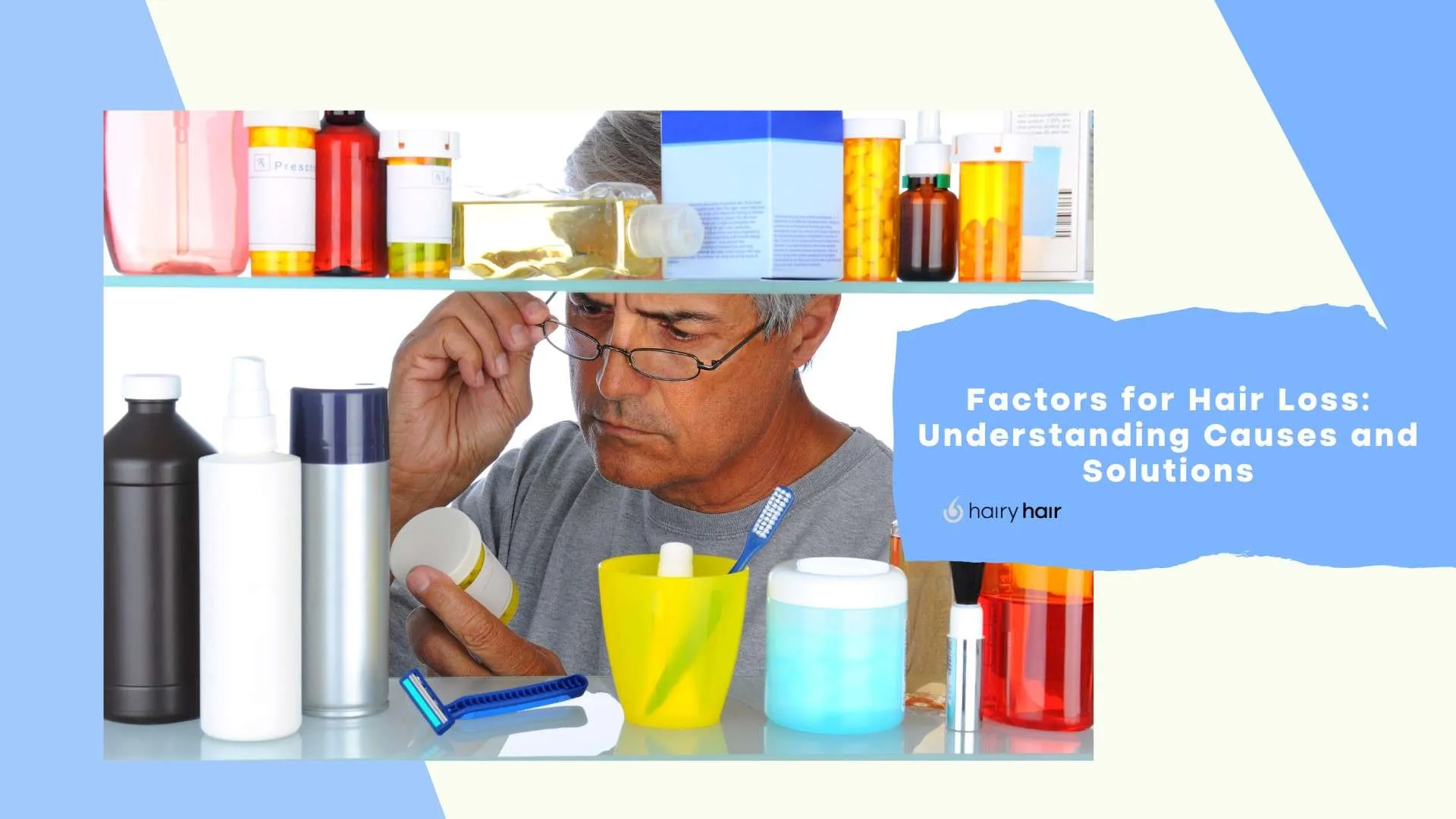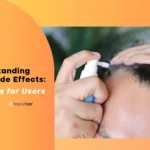Factors for Hair Loss: Understanding Causes and Solutions

To improve your hair growth it’s important to understand the factors for hair loss. There can be many underlying factors that influence hair loss. To have the best chance at fighting your hair loss you need to understand what is causing it. Here we will look at what causes hair loss and how it can be treated.
We’ll also see how you can make lifestyle and environmental changes to give you the best chance for hair regrowth. Finally, we’ll show you how Hairy Hair may help you tackle your hair loss by providing a comprehensive treatment that fights a range of causes of hair loss.
- Understanding hair loss
- What are the risk factors for hair loss?
- What are the symptoms and diagnosis of hair loss?
- What is the prevention and treatment for hair loss?
- How can nutrition impact hair loss?
- How can Hairy Hair help me?
- Final thoughts
Understanding hair loss
Hair loss is a condition where hair falls out from the scalp or body and is not replaced by new hair growth. Hair loss, also known as alopecia, is a common condition that affects both men and women.
It can be temporary or permanent and can affect the scalp or entire body. Hair loss can be caused by a variety of factors, including genetics, hormonal changes, medical conditions, and aging.
It can be caused by a disruption in the hair growth cycle, or by damage to the hair follicles. Hair loss can be a sign of an underlying medical condition that requires treatment.
Genetic and hormonal factors
Genetic factors can play a role in hair loss, particularly in cases of androgenic alopecia. Androgenic alopecia is the most common type of progressive hair loss.
Hormonal changes, such as those that occur during menopause or pregnancy, can also contribute to hair loss.
Imbalances in hormones such as testosterone and estrogen can lead to hair loss.
Lifestyle and environmental factors
Alopecia areata and primary cicatricial alopecia are examples of immune-mediated alopecia.
Certain lifestyle factors, such as excessive heat styling, can contribute to hair loss.
Environmental factors, such as exposure to pollution and UV radiation, can also contribute to hair loss.
Poor diet and nutrition can also play a role in hair loss. Telogen effluvium is a scarless hair loss condition caused by physiological stress.
What are the risk factors for hair loss?
Age is a significant risk factor for hair loss, with most people experiencing some degree of hair loss as they age.
A family history of hair loss can also increase a person’s risk of experiencing hair loss.
Certain medical conditions, such as thyroid disorders and autoimmune diseases, can also increase the risk of hair loss.
Age and hair loss
Hair loss can occur at any age, but it is most common in older adults. Hereditary hair loss with age is the most common cause of baldness.
As people age, the growth cycle of hair slows down, and the hair follicles produce thinner, shorter hairs.
Age-related hair loss can be treated with a variety of methods, including medication and hair transplantation.
What are the symptoms and diagnosis of hair loss?
The symptoms of hair loss can vary depending on the underlying cause.
Common symptoms include excessive hair loss, patchy hair loss, and slow hair loss.
- Excessive hair loss, particularly on the scalp, is a common symptom of hair loss.
- Patchy hair loss, where hair falls out in patches, can be a symptom of certain medical conditions.
- Slow hair loss, where hair falls out gradually over time, can be a symptom of aging or hormonal changes.
Diagnosing hair loss
Diagnosing hair loss typically involves a physical examination and medical history.
A dermatologist may perform a scalp examination to look for signs of hair loss.
Blood tests may be ordered to rule out underlying medical conditions.
What is the prevention and treatment for hair loss?
Preventing hair loss involves addressing the underlying cause of the condition.
Treatment options for hair loss include medication, hair transplantation, and low-level laser therapy.
Preventing hair loss
Maintaining a healthy diet and lifestyle can help promote hair growth and prevent hair loss.
Reducing stress and getting regular exercise can also help prevent hair loss.
Treatment options
Medications can be used to treat hair loss.
There are numerous effective, readily available hair growth promoters that not only stimulate robust new growth but also help prevent further hair loss.
These medications can be used to treat a variety of types of hair loss, including androgenic alopecia and female pattern hair loss.
Hair growth promoters can be used in conjunction with other treatments, such as hair transplantation and low-level laser therapy.
- Hair transplantation involves transplanting healthy hair follicles from one part of the body to another.
- Low-level laser therapy can be used to stimulate hair growth and prevent further hair loss.
How can nutrition impact hair loss?
A healthy diet that is rich in nutrients can help promote hair growth and prevent hair loss.
Foods that are high in protein, biotin, and vitamin B can help promote hair growth. Vitamin A is necessary for maintaining healthy hair follicles and promoting growth phases. Vitamin A overconsumption can lead to hair loss or other health issues so it’s important to monitor your intake levels.
Micronutrients are critical elements of the diet for hair health.
A diet that is deficient in essential nutrients can contribute to hair loss.
- Iron deficiency is linked to hair loss and is the most common dietary deficiency.
- Zinc deficiency can cause telogen effluvium and brittle hair.
Foods for hair growth
Foods that are high in protein, such as fish and eggs, can help promote hair growth.
Biotin foods, such as nuts and leafy greens, can stimulate hair growth as they allow for the development of keratin, a critical protein in the production of hair strands.
Foods that are high in vitamin B, such as whole grains and legumes, can help increase your hair growth.
How can Hairy Hair help me?
Hairy Hair may help to manage hair loss by working on multiple fronts. The medication may help to block the production of dihydrotestosterone (DHT) which causes hair follicles to shrink and eventually leads to hair loss. It can also potentially widen the blood vessels in the scalp to allow for more oxygen and nutrients to reach your hair follicles.
Our formula also includes natural hair growth solutions. By addressing different factors for hair loss, Hairy Hair may provide you with a comprehensive treatment to give you the potential to help restore your hair.
To start your hair growth journey just fill in a quick online questionnaire so we can get to know you and your hair loss. From there, one of our qualified Australian GPs will review your information and design your treatment plan. They’ll give you a call to discuss the Hairy Hair pill and answer any questions you may have. Finally, your prescription will be sent straight to your door with express delivery.
Final thoughts
Understanding the factors for hair loss is crucial for tackling your hair loss. A range of issues could be causing your hair loss from genetics to hormones, aging and lifestyle. Knowing what is causing your hair loss allows you to seek targeted treatment that is designed to help you regain your hair.
If you’re worried about your hair loss and want to start making a difference contact Hairy Hair today. Our personalised treatment allows you to receive unlimited support as we guide you through every step of your potential hair regrowth journey. Everyone’s hair loss is unique so choose a treatment that works with you.
In This Article
Overview
Most Trending Articles


